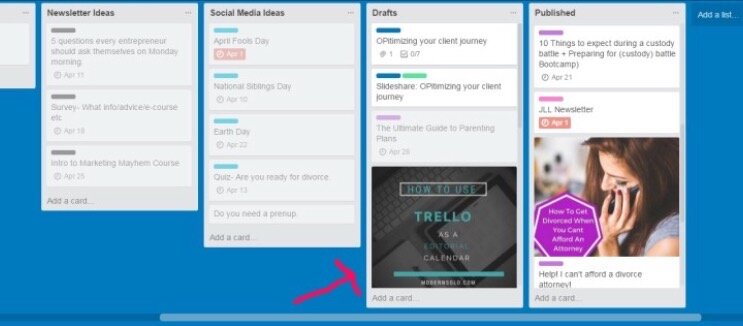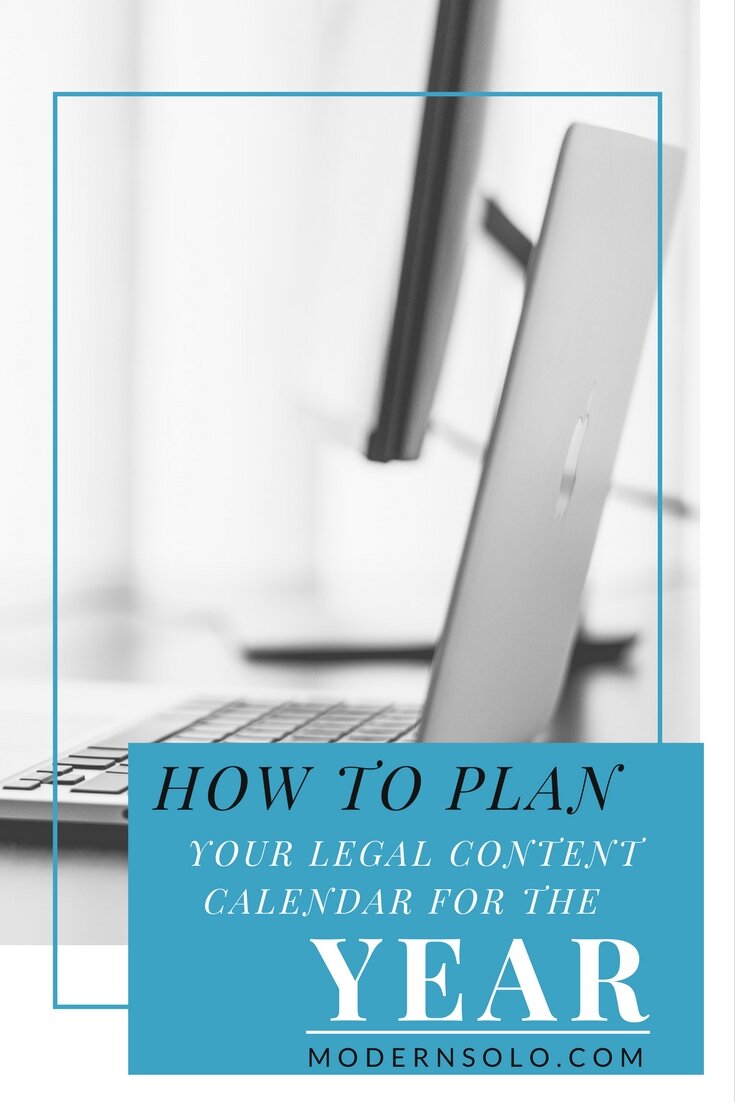How To Plan Your Legal Content For The Year
There are two reasons most solos don’t have a consistent legal content strategy: 1) They don’t know what content to create and; 2) They believe they don’t have time to do it.
This post is going to show you how to plan out your content for the year so you never have to spend time deciding what to post and you can prepare it in advance when you have the time.
Why You Need A Content Calendar
There are several benefits to planning your content out in advance:
- You can post and share consistently if you already have topics planned in advance.
- You can get a bird's eye view of what content you have planned, which makes it easier to fill in the gaps. Again, consistency.
- You can tie your content to holidays and business events. If you have a seminar planned in June, you can share content related to the topic leading up to the seminar to build excitement.
- You can prepare your content well in advance of publishing. Instead of publishing anything to get something out, you can strategically plan high-quality content that is timely and relevant. Giving you a higher ROI for your efforts.
Even if you decide to have someone else create your content, you should personally be involved in creating your content calendar so you have control over what is shared and when. This is the best way to stay true to your brand and be a consistent voice to your audience.
Step 1: Choose A Calendar
There are several different types of calendars you can use to plan your legal content. From spreadsheets to apps, to pen and paper, the options are endless.
I like the ability to easily move content around, add pictures, links, and notes, so I’ve found Trello to be the best tool to use as my legal content calendar.
There are also tools like Buffer, Hootsuite, and Coschedule that can help you publish your scheduled content.
So I use Trello for planning and every month move the content for that month to scheduling software.
Step 2: Schedule Major Events & Holidays
Next, you want to plus in major holidays and events into your calendar so you create related content. For social media, I like to include some of the unusual “hashtag holidays” because it usually gets me a boost in engagement and can be a fun way to show the human side of my business. I use National Day Calendar to find these dates.
These holidays and national months can also help you with the next step, content themes.
Step 3: Plan Content Themes
Content themes are when you share content on a certain topic on a specific day, week, or month.
For example, if you are a family law attorney you may share content about divorce on Monday, Child Support on Tuesday, Child Custody on Wednesday and so on. This helps your audience learn what to expect from you and when. And it makes it easier for you to evenly touch on all areas of practice.
Another way to plan legal content themes is by month. This is the way I usually do it. You don’t necessarily have to announce your monthly theme, but it makes it easier internally to plan content.
For example, October is Domestic Violence Awareness month so most of my content centered around that theme. In January my theme may be starting fresh in the new year so I would post about starting a divorce. In April my theme may be how divorce affects finances and taxes.
Having a theme makes it easier to come up with timely, relevant content. It narrows down the topics you have to choose from and can give your audience a more comprehensive view of a particular subject.
Step 4: Plan Content Types
After the themes, you want to think of the types of content to include. Content is more than just blog posts, there are many useful things to share. Some of the content types I find useful for the legal field are:
- Blog posts
- Webinars
- Videos
- E-books
- Emails
- E-courses
- Quotes
The best thing about using different content types is that you can repurpose content. You can turn a blog post into a video or slipes. Or turn each topic from a list into an Instagram post. More content for just a little more effort.
Step 5: Fill In The Topics
The last step is to fill in the specific topics. You can do a year's worth in advance, each quarter, each month, or each week. I find that planning as far in advance as possible makes my life easier. If I have topics planned already I can spend more time writing.
Don’t know what to write about? Reach out to your audience. I get topic ideas from:
- Questions from Clients
- Questions from prospective clients
- Questions on Social Media
- Questions on Quora
- Questions on Avvo
- Repurpose my high performing content
Having the topics in advance let you know what you plan to write about. But plans can change and you can always update as the year goes on and you get more content ideas.
Consistently sharing high quality, relevant content is an easy and affordable way to market your solo law practice. Like everything else, having a strategy will make you more successful. Do you plan your content in advance? Share in our Solo Lawyer Facebook group.



